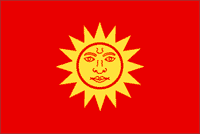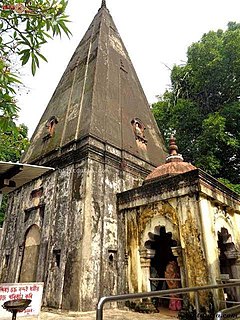
Kamarupa, an early state during the Classical period on the Indian subcontinent, was the first historical kingdom of Assam.

Sadiya is a town in Tinsukia district, Assam, India and was the third capital of Chutia Kingdom established by the second Sutiya ruler Ratnadhwajpal in 1248 and remained as the capital till 1524. Extensive remains of buildings and fortifications built during the rule of the Chutias near Sadiya still point to the importance of the region in the past. Historically Sadiya included the entire districts of Lakhimpur, Dhemaji and Tinsukia. It was the center of development of the Eastern form of Prakrit during both the Chutia and Ahom periods, which later gave rise to the modern form of Assamese. Its stands on a grassy plain, almost surrounded by forested Himalayan mountains, on the right bank of Lohit River which is locally considered the main stream of the Brahmaputra river. Sadiya is famous for a flower named satphul, which is much like Jasmine.

The history of Assam is the history of a confluence of people from the east, west, south and the north; the confluence of the Tibeto-Burman (Sino-Tibetan), Indo-Aryan and Austroasiatic cultures. Although invaded over the centuries, it was never a vassal or a colony to an external power until the third Burmese invasion in 1821, and, subsequently, the British ingress into Assam in 1824 during the First Anglo-Burmese War.

The Koch dynasty (Pron:kɒʧ), was a dynasty that ruled regions in the eastern part of the Indian subcontinent, mainly the regions of what is now considered as Assam and Bengal which emerged in erstwhile western Kamarupa kingdom; it is named after the Koch community, emerged as the dominant ruling house in the Kamata kingdom in 1257 CE. and after the fall of the Khen dynasty in 1498 CE. The first of the Koch kings, Viswa Singha and then his sons, Nara Narayan as the subsequent king and Chilarai as the general, soon occupied the western portion of the erstwhile Kamarupa Kingdom as well as some regions of south Assam. The dynasty forked for the first time into two major branches that controlled Koch Bihar and Koch Hajo. Koch Bihar became a vassal of the Mughals, whereas Koch Hajo came under Ahom control and was subsequently absorbed. Koch Bihar became a princely state during British rule and was absorbed after Indian independence. The third branch of this dynasty at Khaspur disappeared into the Kachari kingdom.

The Kamata Kingdom emerged in western Kamarupa probably when Sandhya, a ruler of Kamarupanagara, moved his capital west to Kamatapur sometime after 1257 CE. Since it originated in the old seat of the Kamarupa kingdom, and since it covered most of the western parts of it, the kingdom is also sometimes called as Kamarupa-Kamata.
The Moamoria rebellion (1769–1805) was the 18th century uprising in Ahom kingdom of present-day Assam that began as power struggle between the Moamorias, the adherents of the Moamara Sattra, and the Ahom kings. This uprising spread widely to other sections of Ahom kingdom including disgruntled elements of the Ahom aristocracy leading to two periods in which the Ahom king lost control of the capital. Retaking the capital was accompanied by a massacre of subjects, leading to a steep depopulation of large tracts. The Ahom king failed to retake the entire kingdom; a portion in the north-east, Bengmara, became known as Matak Rajya ruled by a newly created office called Borsenapati, became a tribute-paying but virtually independent territory.

Suhungmung was one of the most important Ahom kings who ruled at the cusp of Assam's medieval history. His reign broke from the early Ahom rule and established a multi-ethnic polity in his kingdom. Under him the Ahom Kingdom expanded greatly for the first time since Sukaphaa, at the cost of the Chutiya and the Dimasa kingdoms. He also successfully defended his kingdom against Muslim invasions, first by a general called Bar Ujjir and another by Turbak Khan. During his time, the Khen dynasty collapsed and the Koch dynasty ascended in the Kamata kingdom. His general, Ton-kham, pursued the Muslims up to the Karatoya river, the western boundary of the erstwhile Kamarupa Kingdom, the farthest west an Ahom king had ventured in its entire six hundred years of rule.

Habung is a historical region in Dhemaji district of Assam. As per epigrahic records, Habung (Ha-vrnga-Vishaya) was a Visaya or province where Brahmins were settled by Ratna Pala of the Pala dynasty of Kamarupa in the 10th century.
Naranarayan was the last ruler of the undivided Koch kingdom of Kamata. He succeeded his father, Biswa Singha. Under him the Koch kingdom reached its cultural and political zenith. Under his rule, and under the military command of his brother Chilarai, he was able to subjugate the entire Brahmaputra valley, including the Ahom kingdom; besides the Kachari, Tripura and Manipur kingdoms, as well as the Khyrem, Jaintia and others. This influence was halted when he faced Suleman Karranni of Bengal.
Upper – Assam is an administrative division of the state of Assam comprising the undivided Lakhimpur and Sivasagar districts, of the upper reaches of the Brahmaputra valley. The other divisions are: Lower – Assam, North Assam and Hills and Barak Valley. The division is under the jurisdiction of a Commissioner, stationed at Jorhat.

The Chutia Kingdom was a late medieval state that developed around Sadiya in Assam and adjoining areas in Arunachal Pradesh. It extended over almost the entire region of present districts of Lakhimpur, Dhemaji, Tinsukia and some parts of Dibrugarh. The kingdom fell in 1523 to the Ahom Kingdom after a series of conflicts and the area ruled by the Chutia rulers became the administrative domain of the office of Sadia Khowa Gohain of the Ahom kingdom.

Ita Fort in Itanagar town, is one of the most important historical sites in the state of Arunachal Pradesh, India. The name literally means "Fort of bricks". It also lends its name to the city Itanagar, the capital of Arunachal Pradesh. The Ita Fort at Arunachal Pradesh was built as early as the 14th or the 15th century by kings of the Chutia dynasty. The fort has an irregular shape, built mainly with bricks dating back to the 14th-15th Century. The total brickwork is of 16,200 cubic metre lengths which was probably built by kings of the Chutiya kingdom which ruled the region during that time. The fort has three different entrances at three different sides, which are western, the eastern and the southern sides.

Sudangphaa (1397–1407) was the king of the Ahom kingdom. He was popularly known as Bamuni Konwar because of his upbringing in a Brahman's house. His reign marks the first stage in the growth of Hinduism in the Ahom dynasty. He initiated the Singarigharutha ceremony of the Ahom kings, a tradition which was followed by his successors.

Kamrup is the modern region situated between two rivers, the Manas and the Barnady in Western Assam, with the same territorial extent as the Colonial and post-Colonial "Undivided Kamrup district". It was the capital region of two of the three dynasties of Kamarupa and Guwahati, the current political center of Assam, is situated here. It is characterized by its cultural artifacts.

Undivided Kamrup district is a former administrative district located in Western Assam from which Kamrup Rural (2003), Kamrup Metropolitan (2003), Barpeta (1983), Nalbari (1985) and Baksa (2004) Kamrup South (2015) districts were formed. It was announced in January 2020 that the Bajali sub-division of Barpeta district will be upgraded to a full district.

The Chutia people are peoples from Assam who are associated with the historic Chutia kingdom. The Chutia kingdom's territory encompassed the Lakhimpur, Dhemaji, Dibrugarh and Tinsukia districts of Assam; but after the kingdom was absorbed into the Ahom kingdom in 1523-24 the Chutiya population was widely dispersed in the entire Upper Assam. Ethnically, they are part of the Bodo-Kachari group, and constitute one of the core groups that form the Assamese people.

Basudev Than or Narua Satra is a satra located in Dhakuakhana, Lakhimpur, Assam. It was first established in the 14th century by the Chutia king Satyanarayan. Originally known as Laumura Satra, this satra is well known in Assam and other parts of India.

Malinithan is an archaeological site which consists of ruins of a Hindu temple of the early medieval period on the northern bank of the Brahmaputra River in the Indian state of Arunachal Pradesh. The archaeological studies of the ruins indicate that the temple was built with granite stones during the period of Hinduism influence in the region. It was built by Chutiya kings in the 13th-14th century. This was the period when the Chutiya kings had started setting Brahmins in different areas of their kingdom offering them land grants. Kechai-Khaiti, a Chutia tribal goddess was believed to be the chief deity who was worshipped in the ruined temple. The location of a narrow stream named Akashiganga similar to the site of Tamreswari and Bura-Buri Temples of Sadiya indicates that sacrifices were once performed in the temple.
Birpal is a legendary founder of Chutia kingdom. He claimed descent from an ancestral king named Virmukka. As per the Assamese manuscripts, due to some misfortune(deva-dosha) Birpal had to settle down with 60 Chutia families in a hill named Swarnagiri/Sonagiri in the year 1189 A.D.(1111 saka) where he assumed the title Gayapal. As per Chutia folklore, Birpal was an ardent worshiper of Kubera. It is believed that Kubera had come to his dream and foretold that a son would be born who would go on to become a great and benevolent king. Kubera gifted Birpal the royal heirlooms ; which were found under a tree that he worshiped. Kubera also warned him that if his descendants ever disrespected Kubera or the heirlooms, the umbrella would break and it will lead to downfall. He was succeeded by his son Ratnadhwajpal assuming the title of Gaudinarayan.

The Moamoria were the adherents of the egalitarian, proselytizing Moamara sattra of 18th-century Assam, who initiated the Moamoria rebellion against the Ahom kingdom in the 18th century. The rebellion weakened the Ahom kingdom to such an extent that the kingdom became vulnerable to repeated Burmese invasions of Assam and the subsequent colonization by the British. The Moamorias were also called Mataks, most of who belonged to the Kachari Moran ethnic group. Over time, the main groups that had supported the Ahom kingdom came to owe allegiance to the Moamara sattra: Morans, the Sonowal Kacharis (gold-washers), Chutias, professional castes such as Hiras (potters), Tantis (weavers), Kaibartas and Ahom nobles and officers.













